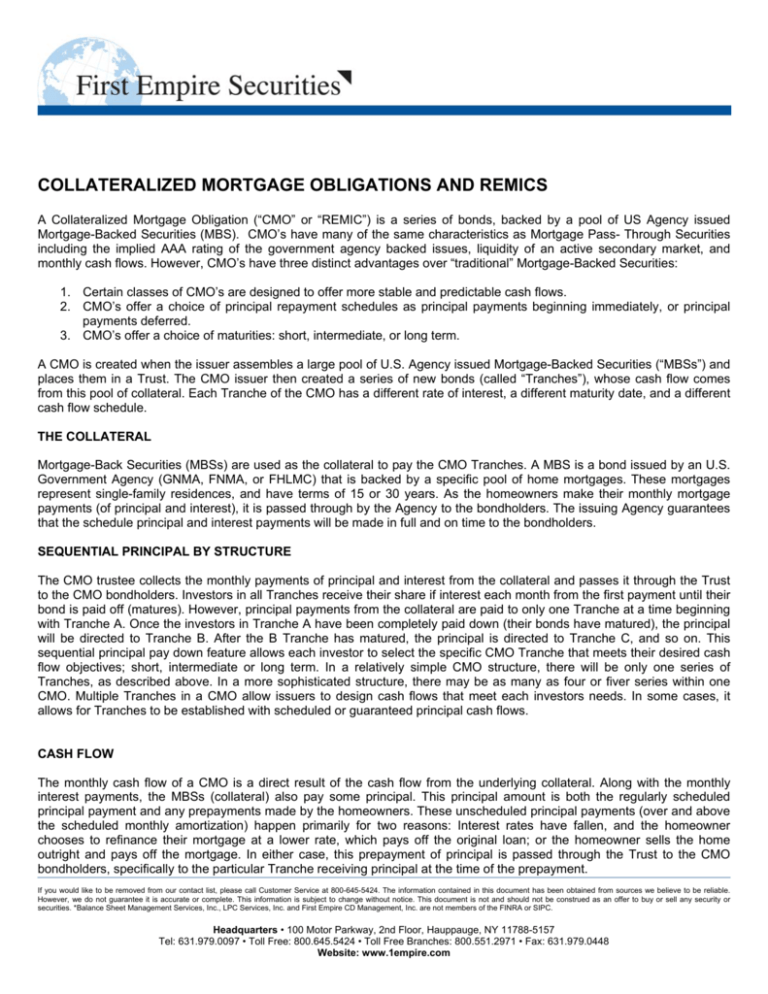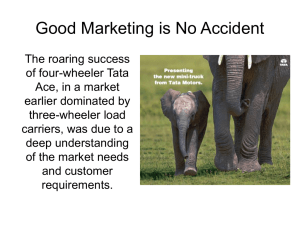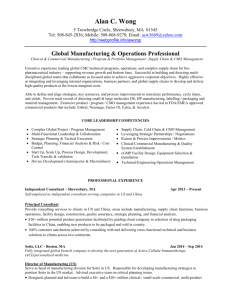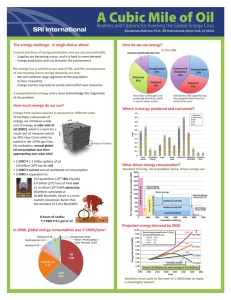collateralized mortgage obligations and remics
advertisement

COLLATERALIZED MORTGAGE OBLIGATIONS AND REMICS A Collateralized Mortgage Obligation (“CMO” or “REMIC”) is a series of bonds, backed by a pool of US Agency issued Mortgage-Backed Securities (MBS). CMO’s have many of the same characteristics as Mortgage Pass- Through Securities including the implied AAA rating of the government agency backed issues, liquidity of an active secondary market, and monthly cash flows. However, CMO’s have three distinct advantages over “traditional” Mortgage-Backed Securities: 1. Certain classes of CMO’s are designed to offer more stable and predictable cash flows. 2. CMO’s offer a choice of principal repayment schedules as principal payments beginning immediately, or principal payments deferred. 3. CMO’s offer a choice of maturities: short, intermediate, or long term. A CMO is created when the issuer assembles a large pool of U.S. Agency issued Mortgage-Backed Securities (“MBSs”) and places them in a Trust. The CMO issuer then created a series of new bonds (called “Tranches”), whose cash flow comes from this pool of collateral. Each Tranche of the CMO has a different rate of interest, a different maturity date, and a different cash flow schedule. THE COLLATERAL Mortgage-Back Securities (MBSs) are used as the collateral to pay the CMO Tranches. A MBS is a bond issued by an U.S. Government Agency (GNMA, FNMA, or FHLMC) that is backed by a specific pool of home mortgages. These mortgages represent single-family residences, and have terms of 15 or 30 years. As the homeowners make their monthly mortgage payments (of principal and interest), it is passed through by the Agency to the bondholders. The issuing Agency guarantees that the schedule principal and interest payments will be made in full and on time to the bondholders. SEQUENTIAL PRINCIPAL BY STRUCTURE The CMO trustee collects the monthly payments of principal and interest from the collateral and passes it through the Trust to the CMO bondholders. Investors in all Tranches receive their share if interest each month from the first payment until their bond is paid off (matures). However, principal payments from the collateral are paid to only one Tranche at a time beginning with Tranche A. Once the investors in Tranche A have been completely paid down (their bonds have matured), the principal will be directed to Tranche B. After the B Tranche has matured, the principal is directed to Tranche C, and so on. This sequential principal pay down feature allows each investor to select the specific CMO Tranche that meets their desired cash flow objectives; short, intermediate or long term. In a relatively simple CMO structure, there will be only one series of Tranches, as described above. In a more sophisticated structure, there may be as many as four or fiver series within one CMO. Multiple Tranches in a CMO allow issuers to design cash flows that meet each investors needs. In some cases, it allows for Tranches to be established with scheduled or guaranteed principal cash flows. CASH FLOW The monthly cash flow of a CMO is a direct result of the cash flow from the underlying collateral. Along with the monthly interest payments, the MBSs (collateral) also pay some principal. This principal amount is both the regularly scheduled principal payment and any prepayments made by the homeowners. These unscheduled principal payments (over and above the scheduled monthly amortization) happen primarily for two reasons: Interest rates have fallen, and the homeowner chooses to refinance their mortgage at a lower rate, which pays off the original loan; or the homeowner sells the home outright and pays off the mortgage. In either case, this prepayment of principal is passed through the Trust to the CMO bondholders, specifically to the particular Tranche receiving principal at the time of the prepayment. If you would like to be removed from our contact list, please call Customer Service at 800-645-5424. The information contained in this document has been obtained from sources we believe to be reliable. However, we do not guarantee it is accurate or complete. This information is subject to change without notice. This document is not and should not be construed as an offer to buy or sell any security or securities. *Balance Sheet Management Services, Inc., LPC Services, Inc. and First Empire CD Management, Inc. are not members of the FINRA or SIPC. Headquarters • 100 Motor Parkway, 2nd Floor, Hauppauge, NY 11788-5157 Tel: 631.979.0097 • Toll Free: 800.645.5424 • Toll Free Branches: 800.551.2971 • Fax: 631.979.0448 Website: www.1empire.com AVERAGE LIFE Once a specific CMO Tranche begins to pay principal, the investors can receive varying amounts of principal each month until maturity. Because of this variability, the term Weighted Average Life (“WAL or average life”) was created to better measure the length of a CMO investment. Average life is the point in time when a ½ of the principal investment has been repaid. Therefore, average life is dependent upon the rate of repayments. If repayments increase, average life shortens. Conversely, if prepayments decrease, average life lengthens. P.S.A. (PUBLIC SECURITIES ASSOCIATION PREPAYMENT MODEL) The most common method of monitoring prepayments on a CMO is the Public Securities Association prepayment model (“PSA”). PSA is a numerical scale that is used to measure the exact rate of principal prepayments on the underlying Mortgage-Backed Securities, and to make educated assumptions on the future rate of prepayments. If the homeowners do not make any prepayments, the collateral is said to be paying at 0% PSA. The faster the rate of principal prepayments, the higher the PSA (i.e.: 50% PSA, 100% PSA, 200% PSA, etc.). The PSA is the most helpful to the CMO investor when a specific Tranche is evaluated under multiple prepayment scenarios. Declining interest rates tend to accelerate prepayment speeds while increasing interest rates tend to slow prepayment speeds. Prepayment rates have a direct effect on yield and are not the same as conventional debt securities. The yield and average life of CMOs will fluctuate depending on actual prepayments. Principal may be returned sooner than expected due to accelerated prepayment speeds and be reinvested at lower market rates. Consequently, longer prepayment speeds may return principal later than expected and opportunities to invest in higher rates may be lost. The yield to maturity (“yield”) on a CMO is a combination of the stated rate of interest (the “coupon’ rate), the price paid for the CMO (below face value – “discount” or above face value – “premium”) and the rate of prepayments. Since prepayments have a direct influence on a CMO’s yield, it is important for the CMO investor to remember: CMO’S PURCHASED AT A DISCOUNT: Faster prepayments increase yield and shorten average life. Slower prepayments decrease yield and lengthen average life. CMO’S PURCHASED AT A PREMIUM: Faster prepayments decrease yield and shorten average life. Slower prepayments increase yield and lengthen average life. The variability of principal prepayments and its affect on both yield and average life is the reason investors demand a higher yield on CMO’s than other AAA rated securities. The extent of Government guarantees on defaults applies only to the par value and not to any premium paid. TYPES OF CMO TRANCHES PAC BOND (Planned Amortization Class) – A CMO Tranche with scheduled cash flows within a stated range of prepayment speeds, called the “PAC Range”. With a PAC tranche, the yield, average life, and lockout periods estimated at the time of purchase are more likely to remain stable over the life of the security. Therefore, they offer a higher degree of investor cash flow certainty over other types of CMO tranches. TAC BOND (Targeted Amortization Class) – A TAC Bond also has scheduled cash flows. However, TACs are designed to remain stable at one PSA speed and faster. TAC Bonds are created to protect against the risk of faster prepayments (“contraction risk”), but typically offer limited protection against slower prepayments (“extension risk”) and have less cash flower certainty than PACs. If you would like to be removed from our contact list, please call Customer Service at 800-645-5424. The information contained in this document has been obtained from sources we believe to be reliable. However, we do not guarantee it is accurate or complete. This information is subject to change without notice. This document is not and should not be construed as an offer to buy or sell any security or securities. *Balance Sheet Management Services, Inc., LPC Services, Inc. and First Empire CD Management, Inc. are not members of the FINRA or SIPC. Headquarters • 100 Motor Parkway, 2nd Floor, Hauppauge, NY 11788-5157 Tel: 631.979.0097 • Toll Free: 800.645.5424 • Toll Free Branches: 800.551.2971 • Fax: 631.979.0448 Website: www.1empire.com SEQUENTIAL CMO – A CMO with no PAC or TAC Bonds in the structure. Also known as a “Plain Vanilla CMO”. VADM (Very Accurately Defined Maturity) – A VADM has been scheduled cash flows within a stated range of prepayments (similar to a PAC Bond). However, a VADM extends this “guaranteed” cash flow schedule all the way down to 0% PSA (no prepayments at all). Therefore, a VADM has no extension risk, and a “very accurately defined” maturity. COMPANION OR SUPPORT BOND – Support Bonds are the other Tranches within a CMO that contains PAC or TAC Tranches. Support Bonds are dedicated to absorbing excess principal prepayments (under faster PSAs) or giving up needed principal (under slower PSAs) to the PAC or TAC Bonds, in order to maintain scheduled cash flows. The average life of a companion Tranche may vary widely, increasing when interest rates rise and decreasing rates fall. Because of the increased cash flow volatility, companion or support bonds offer the potential for higher expected yields when prepayments remain close to the assumed prepayment rate at purchase. FLOATER TRANCHE – Floaters are a variable rate CMO Tranche. Floaters are quoted at a spread to an index (the LIBOR rate, Cost of Funds Index, or Treasury bond CMT) and will adjust periodically up or down as the index moves up or down. The performance of these investments also depends on the way interest rate movements affect prepayment rates and average lives. INVERSE FLOATER – The Inverse Floater Tranche of a CMO is also an Adjustable Rate Bond. However, as the name implies, the Inverse Floater moves in the opposite direction of the stated index. Simply put, if the general level of interest rates goes down, the Inverse Floater’s rate will go up and visa versa. Inverse floaters are structured to offset floating-rate Tranches. This Tranche class is more leveraged than other Tranches and as a result experiences high priced volatility as interest rates move. I.O. (Interest Only Class)- An I.O. receives cash flow exclusively from the interest payments of the underlying MortgageBacked Securities (the collateral). An I.O. is purchased at a deep discount to face value. If prepayment rates are high, and I.O. investor nay actually receive less cash back then initially invested. P.O. (Principal Only Class) – A P.O. receives cash flow exclusively from the principal payments of the underlying collateral. A P.O. is also purchased at a deep discount to face value. The P.O. class is extremely sensitive to prepayment rates. If interest rates rise and prepayments slow, then the value of the security will decline. Z Bond – A Z Bond is a “Zero Coupon” or accrual Tranche of a CMO. The Z Bond accrues its interest at the coupon rate but instead paying out to the investor, it is reinvested into the principal balance, and then paid out as part of the principal payments. This provides a “compounded interest” effect on the yield. Z Bonds are purchased at a deep discount to face value. Interest on Z Bonds is taxable when credited even though no actual payments are received. EVALUATING A CMO To evaluate the suitability of a particular CMO Tranche an investor should determine the following: What is the assumed prepayment rate (PSA)? When does the principal begin paying? When is the projected final principal payment date? What is the projected average life? What is the projected yield? What type of Tranche is it (i.e. PAC, TAC, Floater, etc)? What is the yield, average life, and principal repayment window if prepayments speed up (higher PSAs) or slow down (lower PSAs)? Does it pass the Federal Financial Institutions Examination Council (FFIEC) High Risk Security Test? If you would like to be removed from our contact list, please call Customer Service at 800-645-5424. The information contained in this document has been obtained from sources we believe to be reliable. However, we do not guarantee it is accurate or complete. This information is subject to change without notice. This document is not and should not be construed as an offer to buy or sell any security or securities. *Balance Sheet Management Services, Inc., LPC Services, Inc. and First Empire CD Management, Inc. are not members of the FINRA or SIPC. Headquarters • 100 Motor Parkway, 2nd Floor, Hauppauge, NY 11788-5157 Tel: 631.979.0097 • Toll Free: 800.645.5424 • Toll Free Branches: 800.551.2971 • Fax: 631.979.0448 Website: www.1empire.com CONCLUSION Since their introduction in 1983, CMO’s have become one of the fastest growing sectors in the fixed income securities market. The attraction for conservative investors is the implied AAA rating of the government agency backed issues, the liquidity of a $750 billion dollar market, and a selection from flexible cash flow structures and maturities. As with all investments, there are inherent risks to these securities, which should be carefully evaluated prior to purchase. As with all debt instruments, the sale prior to maturity may cause capital gain or loss. If you would like to be removed from our contact list, please call Customer Service at 800-645-5424. The information contained in this document has been obtained from sources we believe to be reliable. However, we do not guarantee it is accurate or complete. This information is subject to change without notice. This document is not and should not be construed as an offer to buy or sell any security or securities. *Balance Sheet Management Services, Inc., LPC Services, Inc. and First Empire CD Management, Inc. are not members of the FINRA or SIPC. Headquarters • 100 Motor Parkway, 2nd Floor, Hauppauge, NY 11788-5157 Tel: 631.979.0097 • Toll Free: 800.645.5424 • Toll Free Branches: 800.551.2971 • Fax: 631.979.0448 Website: www.1empire.com








